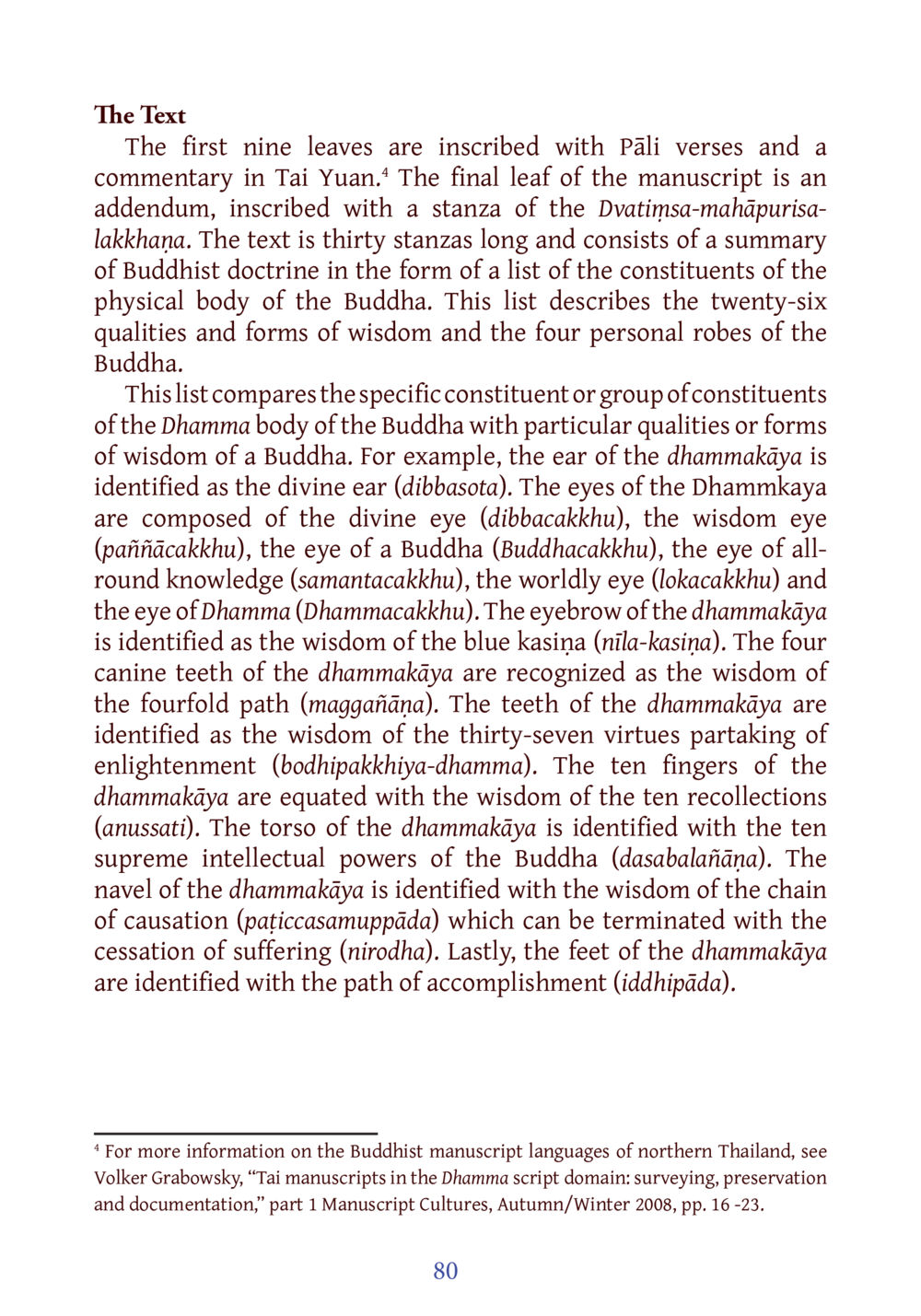Understanding the Pāli Verses and Buddhist Doctrine : หน้า 101/141
DIRI Journal : หน้า 101/141 An exploration of Pāli verses and their commentary in Tai Yuan, detailing the physical attributes and wisdom of the Buddha.
9 ครั้ง

สรุปเนื้อหา
The manuscript presents Pāli verses and commentary in Tai Yuan, summarizing Buddhist doctrines about the Buddha's physical body and wisdom. It includes thirty stanzas highlighting qualities like divine ears and eyes, virtues tied to enlightenment, and attributes of the dharmakāya. These elements reveal the interplay between the physical and the spiritual, demonstrating the depth of Buddhist wisdom. The manuscript appeals to those interested in Buddhist studies, specifically the intricate symbolism of the Buddha's form. More insights into the Buddhist manuscript languages of northern Thailand can be found at dmc.tv.
หัวข้อประเด็น
-Pāli verses
-Tai Yuan commentary
-Buddha's attributes
-Buddhist doctrine
-Dharma body wisdom
ข้อความต้นฉบับในหน้า
The Text
The first nine leaves are inscribed with Pāli verses and a commentary in Tai Yuan.4 The final leaf of the manuscript is an addendum, inscribed with a stanza of the Dvatiṃsa-mahāpuruśa-lakkhaṇa. The text is thirty stanzas long and consists of a summary of Buddhist doctrine in the form of a list of the constituents of the physical body of the Buddha. This list describes the twenty-six qualities and forms of wisdom and the four personal robes of the Buddha.
This list compares the specific constituent or group of constituents of the Dhamma body of the Buddha with particular qualities or forms of wisdom of a Buddha. For example, the ear of the dharmakāya is identified as the divine ear (dibbasota). The eyes of the Dharmkaya are composed of the divine eye (dibbacakkhu), the wisdom eye (paññācakkhu), the eye of a Buddha (Buddhacakkhu), the eye of all-round knowledge (samantacakku), the worldly eye (lokacakkhu) and the eye of Dhamma (Dhammacakku). The eyebrow of the dharmakāya is identified as the wisdom of the blue kasiṇa (nila-kasiṇa). The four canine teeth of the dhammakāya are recognized as the wisdom of the fourfold path (maggāṇaṇa). The teeth of the dhammakāya are identified as the wisdom of the thirty-seven virtues partaking of enlightenment (bodhipakkhiya-dhamma). The ten fingers of the dhammakāya are equated with the wisdom of the ten recollections (anussati). The torso of the dhammakāya is identified with the ten supreme intellectual powers of the Buddha (dasabalāṇaṇa). The navel of the dhammakāya is identified with the wisdom of the chain of causation (paṭiccasamuppāda) which can be terminated with the cessation of suffering (nirodha). Lastly, the feet of the dhammakāya are identified with the path of accomplishment (iddhipāda).
----------------------------------
4 For more information on the Buddhist manuscript languages of northern Thailand, see Volker Grabowsky, “Tai manuscripts in the Dhamma script domain: surveying, preservation and documentation,” part 1 Manuscript Cultures, Autumn/Winter 2008, pp. 16-23.
80
หน้าหนังสือทั้งหมด

1

2

3

4

5

6

7

8

9

10

11

12

13

14

15

16

17

18

19

20

21

22

23

24

25

26

27

28

29

30

31

32

33

34

35

36

37

38

39

40

41

42

43

44

45

46

47

48

49

50

51

52

53

54

55

56

57

58

59

60

61

62

63

64

65

66

67

68

69

70

71

72

73

74

75

76

77

78

79

80

81

82

83

84

85

86

87

88

89

90

91

92

93

94

95

96

97

98

99

100

101

102

103

104

105

106

107

108

109

110

111

112

113

114

115

116

117

118

119

120

121

122

123

124

125

126

127

128

129

130

131

132

133

134

135

136

137

138

139

140

141
หนังสือที่เกี่ยวข้อง
Load More
